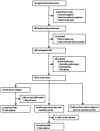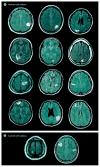Perilesional brain oedema and seizure activity in patients with calcified neurocysticercosis: a prospective cohort and nested case-control study
- PMID: 18986841
- PMCID: PMC3725597
- DOI: 10.1016/S1474-4422(08)70243-6
Perilesional brain oedema and seizure activity in patients with calcified neurocysticercosis: a prospective cohort and nested case-control study
Abstract
Background: Cysticercosis due to Taenia solium is a cause of adult-acquired seizures and epilepsy even in patients with only calcified larval cysts. Transient perilesional brain oedema is seen around the calcified foci but its importance, association with seizures, incidence, and pathophysiology are unknown.
Methods: 110 patients with only calcified lesions and a history of seizures or severe headaches were followed prospectively in a cohort design to assess the incidence of seizure relapse. In a nested case-control substudy, perilesional oedema was assessed by MRI at the time of seizure in symptomatic patients and in matched asymptomatic controls taken from the study population.
Findings: Between November, 1999, and December, 2006, 29 patients had an incident seizure during a median follow up of 32.33 (SD 19.99) months, with an estimated 5-year seizure incidence of 36% (95% CI 25% to 49%). 24 of 29 (83%) patients with seizure relapse had an MRI evaluation within 5 days of the event; perilesional oedema was seen in 12 patients (50%) compared with two (9%) of 23 asymptomatic matched controls.
Interpretation: Perilesional oedema is common and associated with episodic seizure activity in patients with calcified neurocysticercosis. Our findings are probably representative of symptomatic patients in regions where T solium neurocysticercosis is endemic and suggest a unique and possibly preventable cause of seizures in this population.
Conflict of interest statement
Figures



Comment in
-
Perilesional brain oedema in calcific neurocysticercosis: a target to prevent seizure recurrence?Lancet Neurol. 2008 Dec;7(12):1075-6. doi: 10.1016/S1474-4422(08)70244-8. Epub 2008 Nov 3. Lancet Neurol. 2008. PMID: 18986842 No abstract available.
-
Perilesional brain oedema and seizure activity: cause or effect?Lancet Neurol. 2009 Mar;8(3):225; author reply 225-6. doi: 10.1016/S1474-4422(09)70028-6. Lancet Neurol. 2009. PMID: 19233028 No abstract available.
References
-
- Commission on Tropical Diseases of the International League Against Epilepsy Relationship between epilepsy and tropical diseases. Commission on Tropical Diseases of the International League Against Epilepsy. Epilepsia. 1994;35(1):89–93. - PubMed
-
- Garcia HH, Del Brutto OH. Neurocysticercosis: updated concepts about an old disease. Lancet Neurol. 2005;4(10):653–61. - PubMed
-
- Del Brutto OH, Santibanez R, Noboa CA, Aguirre R, Diaz E, Alarcon TA. Epilepsy due to neurocysticercosis: analysis of 203 patients. Neurology. 1992;42(2):389–92. - PubMed
-
- Vazquez V, Sotelo J. The course of seizures after treatment for cerebral cysticercosis. N Engl J Med. 1992;327(10):696–701. - PubMed
-
- Rajshekhar V. Etiology and management of single small CT lesions in patients with seizures: understanding a controversy. Acta Neurol Scand. 1991;84(6):465–70. - PubMed

